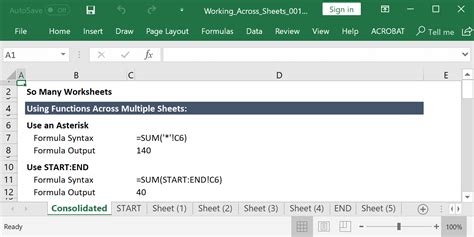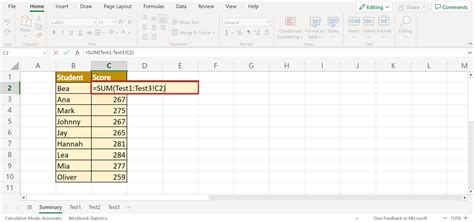Intro
Master Excels sheet-summing capabilities! Learn 5 efficient ways to sum across multiple sheets in Excel, including using formulas, pivot tables, and more. Discover how to consolidate data, use 3D references, and simplify your workflow with these expert tips and tricks for summing across sheets in Excel.
When working with large datasets in Excel, it's not uncommon to have data spread across multiple sheets. In such cases, being able to sum data across these sheets can be incredibly useful for data analysis and reporting. In this article, we'll explore five different methods to sum across sheets in Excel, including using formulas, pivot tables, and more.

Why Sum Across Sheets?
Before we dive into the methods, it's worth understanding why summing across sheets is important. When data is split across multiple sheets, it can be challenging to get a comprehensive view of your data. By summing across sheets, you can:
- Consolidate data from multiple sources
- Get a total view of your data
- Simplify data analysis and reporting
- Improve data accuracy and reduce errors
Method 1: Using the SUM Formula
The simplest way to sum across sheets is by using the SUM formula. This formula allows you to add up values from multiple cells, including those on different sheets.
To use the SUM formula, follow these steps:
- Open your Excel workbook and select the cell where you want to display the sum
- Type
=SUM(and select the first cell or range of cells you want to sum - Press the
+button and select the next cell or range of cells on the next sheet - Repeat this process for each sheet you want to sum
- Close the formula with a
)and press Enter
For example, if you want to sum cells A1 on sheets 1, 2, and 3, your formula would look like this:
=SUM(Sheet1!A1, Sheet2!A1, Sheet3!A1)

Method 2: Using the 3D Reference
A 3D reference is a type of reference that allows you to reference cells across multiple sheets. You can use a 3D reference to sum across sheets by using the SUM formula.
To use a 3D reference, follow these steps:
- Open your Excel workbook and select the cell where you want to display the sum
- Type
=SUM(and select the first cell or range of cells you want to sum - Use the
:operator to specify the range of sheets you want to sum - Close the formula with a
)and press Enter
For example, if you want to sum cells A1 on sheets 1 through 3, your formula would look like this:
=SUM(Sheet1:Sheet3!A1)

Method 3: Using a Pivot Table
Pivot tables are a powerful tool in Excel that allow you to summarize and analyze large datasets. You can use a pivot table to sum across sheets by creating a pivot table that includes data from multiple sheets.
To create a pivot table that sums across sheets, follow these steps:
- Open your Excel workbook and select the cell where you want to create the pivot table
- Go to the "Insert" tab and click on "PivotTable"
- Select the data range you want to use for the pivot table
- Drag the sheet names to the "Row Labels" area of the pivot table
- Right-click on the "Sum" field and select "Value Field Settings"
- In the "Value Field Settings" dialog box, select "Sum" as the calculation type
- Click "OK" to close the dialog box

Method 4: Using VBA Macros
VBA (Visual Basic for Applications) macros are a powerful tool in Excel that allow you to automate tasks and perform complex calculations. You can use a VBA macro to sum across sheets by creating a macro that loops through each sheet and sums the values.
To create a VBA macro that sums across sheets, follow these steps:
- Open your Excel workbook and press "Alt + F11" to open the VBA editor
- In the VBA editor, click on "Insert" and select "Module"
- Paste the following code into the module:
Sub SumAcrossSheets()
Dim ws As Worksheet
Dim total As Double
total = 0
For Each ws In ThisWorkbook.Worksheets
total = total + ws.Range("A1").Value
Next ws
MsgBox "The total is: " & total
End Sub
- Save the macro by clicking on "File" and selecting "Save"

Method 5: Using Power Query
Power Query is a powerful tool in Excel that allows you to connect to external data sources and perform complex data analysis. You can use Power Query to sum across sheets by creating a query that combines data from multiple sheets.
To create a Power Query that sums across sheets, follow these steps:
- Open your Excel workbook and go to the "Data" tab
- Click on "New Query" and select "From Other Sources"
- Select "Excel Workbook" as the data source
- Select the sheets you want to combine and click "OK"
- In the Power Query editor, click on "Add Column" and select "Sum"
- In the "Sum" column, select the column you want to sum
- Click "OK" to close the Power Query editor

Sum Across Sheets in Excel Image Gallery










Conclusion
Summing across sheets in Excel can be a powerful way to analyze and report on data. In this article, we've explored five different methods to sum across sheets, including using formulas, pivot tables, VBA macros, and Power Query. Whether you're a beginner or an advanced user, there's a method that's right for you. By using one of these methods, you can take your data analysis to the next level and make more informed decisions.
What's Next?
- Try out one of the methods we've explored in this article and see how it can help you with your data analysis
- Experiment with different formulas and techniques to sum across sheets
- Share your own tips and tricks for summing across sheets in the comments below
